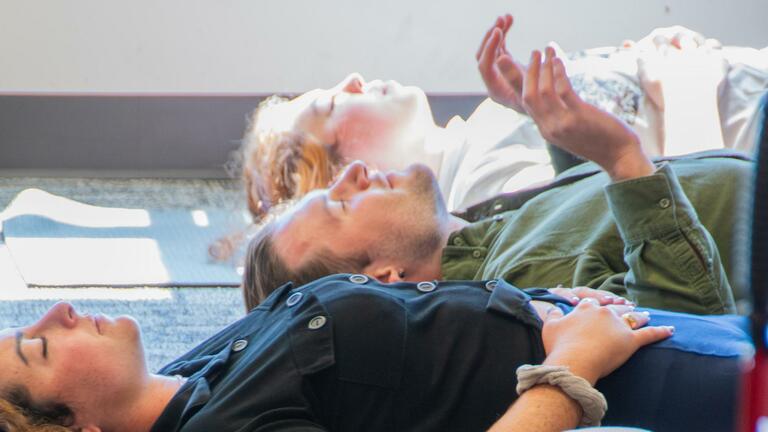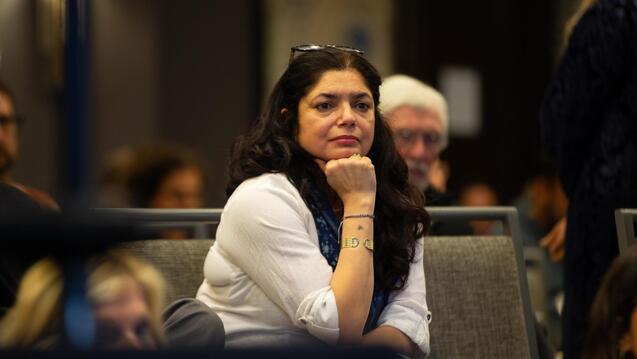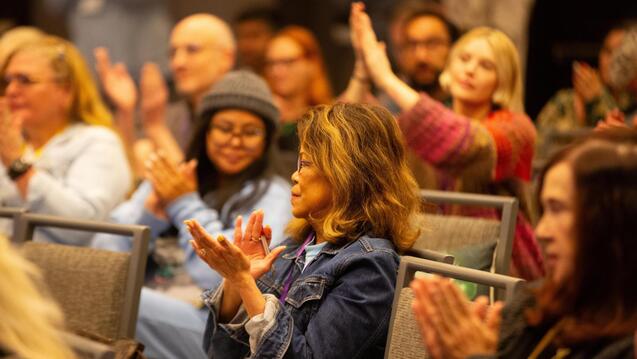The Wall Street Journal spotlights the growing field of integration therapy—and features Center for Psychedelic Therapies and Research Director Dr. Janis Phelps discussing why the work that happens after a psychedelic experience is just as important as the experience itself.

CIIS’ Center for Psychedelic Therapies and Research the Focus of a New York Times Feature on the Power of Holotropic Breathwork
The New York Times travels to CIIS to learn more about the Center for Psychedelic Therapies and Research and the science behind holotropic breathwork.
Editor’s Note: This past October, acclaimed New York Times journalist Ernesto Londoño spent a weekend attending a holotropic breathwork workshop for students enrolled at the Center for Psychedelic Therapies and Research (CPTR) in the final phase of their training and certification to administer psychedelic-assisted treatments for their patients struggling with mental illness. The course, recognized as the first university-based program in the nation, provides health care and mental health professionals with alternative methods of treating patients challenged by PTSD, alcoholism and addiction, severe depression, and myriad other mental health challenges. Londoño, who is the author of an upcoming book on psychedelics (by Times Publishing), spoke with Diane Haug, Founding Director of the Grof Legacy Project USA and senior trainer, , who convened the workshop with Dr. Janis Phelps, Director of CPTR and Dr. Laura Pustarfi, Director of the Certificate Program, as well as several CPTR graduates.
Excerpts from the story
Mental health experts say that traditional interventions to treat depression, trauma and addiction are failing many patients in the United States, which is grappling with a high suicide rate and an opioid addiction epidemic that killed approximately 75,000 people in 2022.
“In psychiatry and psychology, we’ve hit a brick wall,” said Janis Phelps, the director of the Center for Psychedelic Therapies and Research at the California Institute of Integral Studies, the first program of its kind at a university.
Since Dr. Phelps, a psychologist, started the training program in 2015, the quest to resurrect psychedelic medicine has made major leaps.
The training program at the Center for Psychedelic Therapies and Research, which has enrolled more than 1,200 students since 2016, was created with the aim of establishing best practices and ethical guidelines as psychedelics move from the underground to mainstream medicine.
Dr. Caroline J. Hurd, a palliative care doctor from Seattle, enrolled in the certificate program because she had grown frustrated by the limitations and side effects of medications commonly used to alleviate the pain and anguish of terminally ill patients.
“Most of the tools that we have to treat symptoms lead to disconnection,” she said, describing patients who spend their final days groggy and emotionally withdrawn. She was intrigued by clinical studies that showed that psychedelics eased the fear and dread of people facing grim prognoses, allowing them to be more present and emotionally resilient in their final days.
Dr. Bayla Travis, a psychologist in Oakland, Calif., was drawn to the training because she has come to conclude that chronic pain — her specialty — is often a physical manifestation of repressed emotional trauma. In the future, she hopes to help patients confront difficult memories and emotions with the aid of psychedelics.
Dr. Travis said she had embarked on the breathwork session with low expectations because a previous workshop she had participated in had been unremarkable. She was in a cheerful mood when the recent training began, she recalled. But within minutes, Dr. Travis was overcome by a wave of heavy emotions that made her cry and shake as she tapped into what she described as a “deep, deep sorrow that wasn’t particularly about anything.”
After cycling through periods of sadness and bliss, Dr. Travis had a powerful vision as the session was winding down. She saw herself being carried by an adult. The image was deeply soothing. “I think it means I get to be comforted,” Dr. Travis said. The many tears she shed felt a bit mysterious, she added.
“It was like, Oh, this is under the surface and maybe I’ve been walking around with this not having had an opportunity to give it expression.”
Read the full story in The New York Times
Visit the Center for Psychedelic Therapies and Research to learn more about the program.
Related News
As psychedelic use expands beyond clinical settings, CIIS' Dr. Janis Phelps and Center for Psychedelic Therapies and Research graduates emphasize why rigorous training and ethical practices matter—wherever psychedelics are administered.
Multiple major news outlets covered CIIS’ new Bachelor of Science in Psychedelic Studies and the University’s tradition of excellence in consciousness research.



